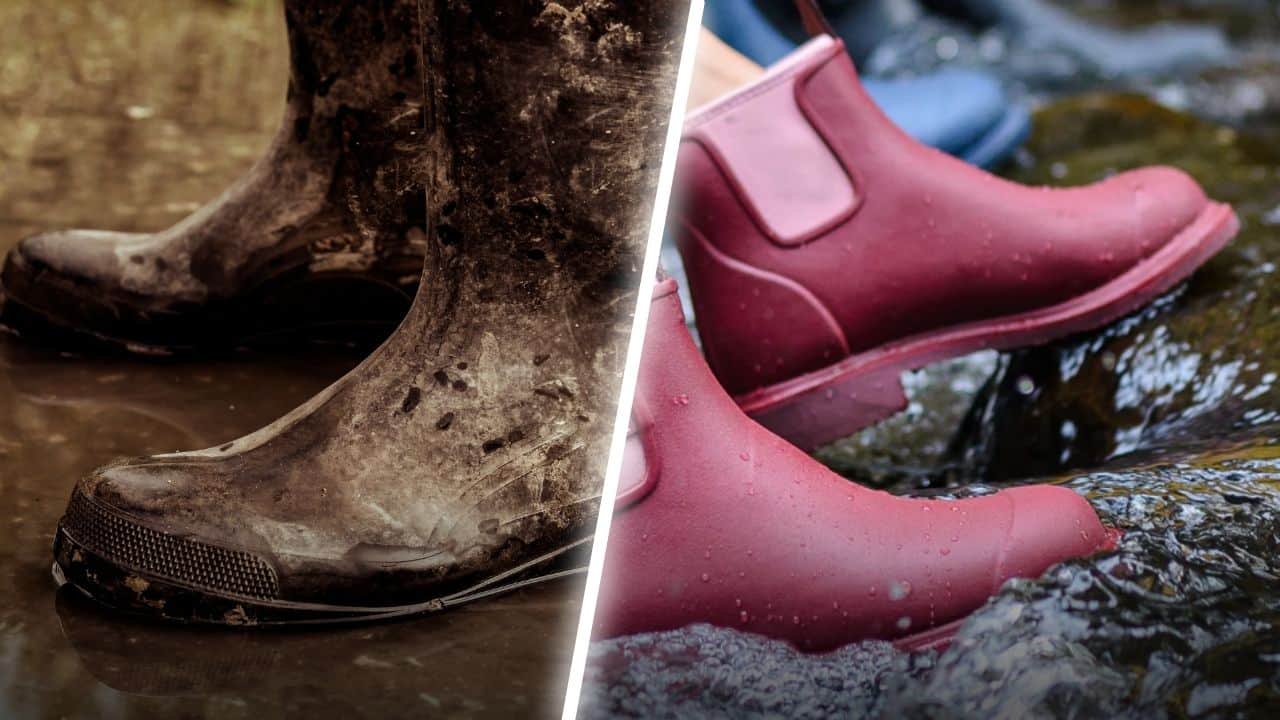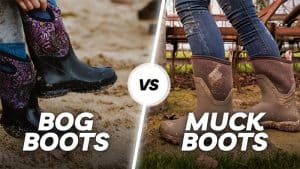When it comes to choosing the right pair of boots for outdoor activities, many factors must be considered. One of the most critical factors is the type of material used to make the boots. Two popular materials used for outdoor boots are rubber and neoprene. Both materials offer distinct advantages and disadvantages, and understanding the differences between the two is crucial in making an informed decision.

In this article, we will compare and contrast the two types of boots and discuss the scenarios where each is ideal. We will also delve into the maintenance and care required for both types of boots to ensure they last a long time. Whether you are a hunter, fisherman, or an outdoor enthusiast, this article will provide you with valuable insights into selecting the right pair of boots for your needs.
Rubber Boots
Rubber boots are an ideal choice for outdoor activities that involve exposure to water or wet environments. This is because rubber is naturally waterproof and can effectively keep the feet dry. These boots are commonly used in activities such as fishing, hunting, farming, and other outdoor work where exposure to water and mud is likely.
One of the significant advantages of rubber boots is their durability. Rubber is a tough material that can withstand harsh conditions and is resistant to wear and tear. This makes rubber boots a long-lasting investment that can save money in the long run.
Rubber boots are also easy to clean. Most of them can be hosed down or wiped with a damp cloth, which makes maintaining them a breeze. This is especially useful for activities like farming, where boots can get muddy and dirty.
However, rubber boots have some disadvantages. One of the main drawbacks is their lack of insulation. Rubber boots are not as well-insulated as neoprene boots, which means they may not be suitable for extremely cold weather. They are also stiff and can restrict movement, which can be uncomfortable during extended wear.
Another disadvantage of rubber boots is their poor breathability. They do not allow for proper ventilation, which can cause the feet to sweat and lead to discomfort. This can also lead to the formation of blisters and other foot problems.
Neoprene Boots
Neoprene boots offer excellent insulation, thanks to their design that traps body heat and prevents it from escaping. This feature makes them ideal for activities that require prolonged exposure to cold and wet environments, such as fishing, hunting, and water sports.
Fun Outdoor Quiz
In addition to insulation, neoprene boots are also designed to be comfortable and flexible. They are made from a soft and pliable material that molds to the foot, providing a custom fit and reducing the risk of blisters and chafing. This flexibility also makes it easier to move and maneuver, making them ideal for activities that require agility and flexibility.
Neoprene boots are also water-resistant, making them ideal for water sports like kayaking, paddleboarding, and surfing. The material used in neoprene boots is water-resistant, meaning that it does not absorb water. This property helps to keep the feet dry and prevents water from seeping into the boots.
However, neoprene boots are generally more expensive than rubber boots due to their higher level of insulation and other features. They are also less durable than rubber boots and may wear out more quickly, especially with frequent use. To maintain their shape and prevent damage, neoprene boots require proper storage, which can be inconvenient for some users.
Additionally, neoprene boots can be too warm for use in hot weather conditions. The insulation that makes them ideal for cold weather activities can be a disadvantage in warm weather conditions, as it may cause the feet to overheat and become uncomfortable. It is essential to consider the weather conditions when deciding which type of boot to use.

Comparison between Rubber Boots and Neoprene Boots
When choosing between rubber boots and neoprene boots, it is essential to consider the advantages and disadvantages of both types of boots and determine which features are most important for your specific needs.
Waterproofing
Rubber boots are naturally waterproof, making them ideal for activities that involve exposure to water, while neoprene boots are water-resistant and can withstand exposure to water but may not be fully waterproof.
Insulation
Neoprene boots provide excellent insulation and are suitable for activities that require exposure to cold and wet environments, while rubber boots provide little to no insulation and may not be suitable for extremely cold weather.
Durability
Rubber boots are known for their durability and can withstand harsh conditions, while neoprene boots are less durable and may wear out more quickly.
Comfort
Neoprene boots are generally more comfortable to wear for extended periods of time due to their soft and flexible material, while rubber boots can be stiff and uncomfortable during extended wear.
Breathability
Neoprene boots allow for proper ventilation and reduce the risk of foot sweat and discomfort, while rubber boots do not provide adequate ventilation and may cause sweating.

Price
Rubber boots are generally less expensive than neoprene boots due to their lower level of insulation and features.
When to use Rubber Boots and Neoprene Boots
Rubber boots and neoprene boots each have unique features that make them suitable for specific activities and environments. Here are some instances when you should consider using rubber boots or neoprene boots:
Rubber Boots:
- Agricultural work: Rubber boots are commonly used in farming, gardening, and other agricultural work that involves exposure to water, mud, and other harsh conditions.
- Fishing and hunting: Rubber boots are also suitable for activities like fishing and hunting, where you need to stand in water or wet environments for extended periods.
- Construction work: Rubber boots with steel-toe caps are commonly used in construction work to provide added protection for the feet.
Neoprene Boots:
- Water sports: Neoprene boots are commonly used in water sports like kayaking, rafting, and surfing, where you need to keep your feet warm and dry in cold water.
- Cold weather activities: Neoprene boots are ideal for activities that require exposure to cold and wet environments, such as snowmobiling, skiing, and ice fishing.
- Diving: Neoprene boots are also commonly used in scuba diving and snorkeling to keep the feet warm in cold water.
Are Neoprene Boots Suitable for Extreme Cold Temperatures?
Neoprene boots are suitable for cold temperatures, but they may not be suitable for extreme cold temperatures. Neoprene boots are designed to provide insulation and keep the feet warm in cold water or mild to moderate cold weather conditions. However, in extremely cold temperatures, neoprene boots may not provide enough insulation to keep the feet warm.
If you plan to use neoprene boots in extremely cold temperatures, you may want to consider wearing thick socks or adding additional insulation to the boots to keep your feet warm. It’s also important to note that neoprene boots are not as durable as rubber boots and may wear out more quickly in harsh conditions, which can affect their ability to provide adequate insulation over time.
Which Type of Boot Is More Comfortable to Wear for Extended Periods of Time?
Generally, neoprene boots are more comfortable to wear for extended periods of time than rubber boots. This is because neoprene is a soft and flexible material that conforms to the shape of the feet, providing a snug and comfortable fit. Neoprene boots also provide better cushioning and shock absorption, which helps to reduce foot fatigue and discomfort during prolonged wear.
On the other hand, rubber boots can be stiff and uncomfortable during extended wear, especially if they do not have a comfortable lining or insole. They also do not provide as much cushioning or shock absorption as neoprene boots, which can lead to foot fatigue and discomfort.

That being said, comfort is a subjective factor that can vary from person to person, and it’s important to choose boots that feel comfortable to you personally. It’s also important to consider the specific activity and environment when choosing between rubber and neoprene boots, as the level of comfort required may differ depending on the circumstances.
Conclusion
Choosing between rubber boots and neoprene boots depends on your specific needs and the activities you plan to undertake. Rubber boots are naturally waterproof and more durable than neoprene boots, making them suitable for activities that involve exposure to water and harsh conditions. On the other hand, neoprene boots provide excellent insulation and are more comfortable for extended periods of wear, making them ideal for activities that require prolonged exposure to cold and wet environments.
When making your decision, consider factors such as waterproofing, insulation, durability, comfort, breathability, and price. Additionally, think about the specific activity and environment where the boots will be used to ensure that they provide the level of protection and comfort you need.









